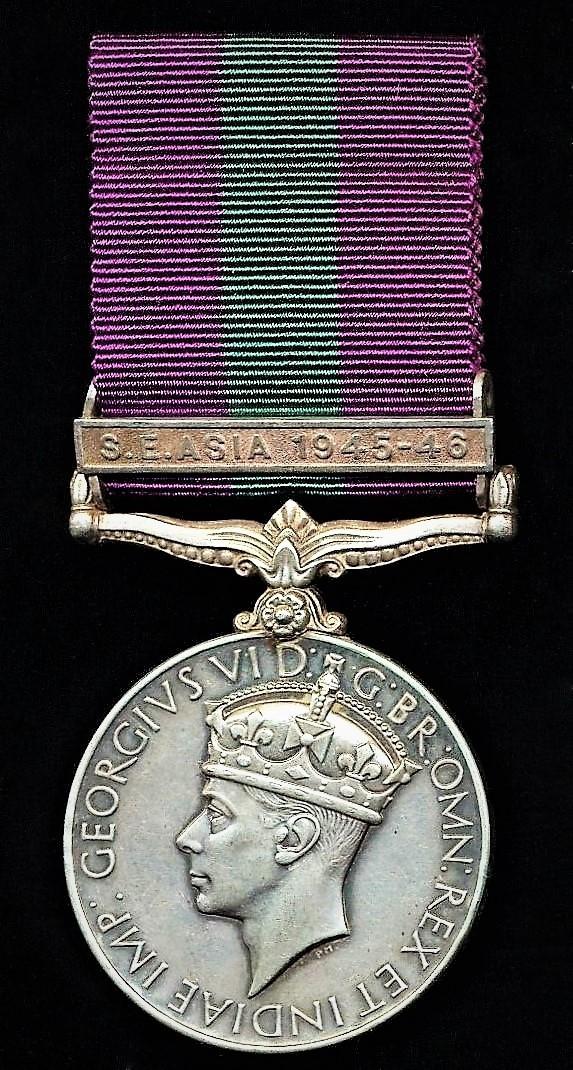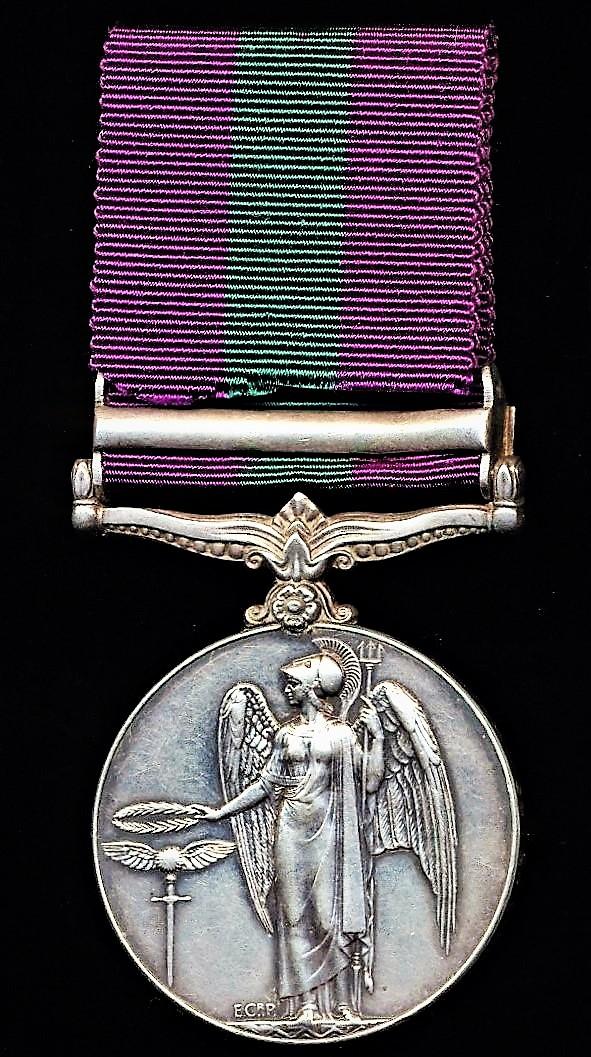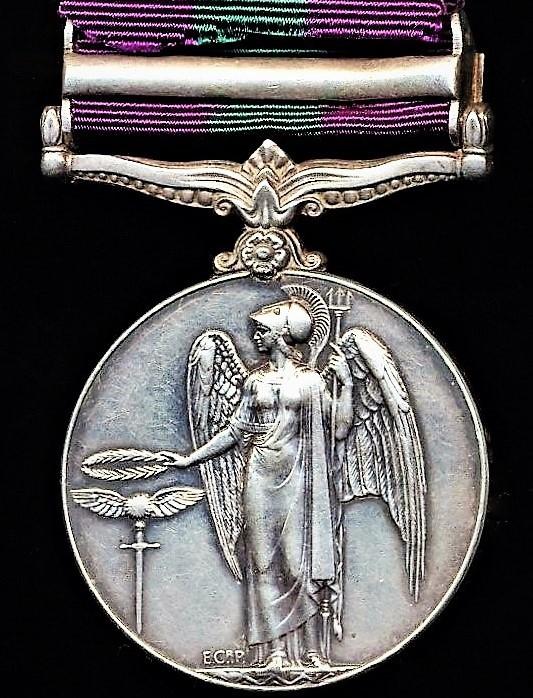General Service 1918-62, 1 clasp, S. E. Asia 1945-46 (28734 L/Nk. Mohan Lal, 14 Bn., F.F. Rif.)
Important: The only 'Infantry' units of the British Empire to serve in French Indochina (Vietnam) and fight against the Viet-Minh in the period 1945-46, were British & Indian Officers, together with Indian & Gurkha VCO's & 'Other Ranks' of the British Indian Army. All of the British Indian Army infantry units to serve in French Indochina had hitherto served in the Burma campaign fighting the Imperial Japanese Army
The recipient was an Indian soldier of Dogra Rajput ethnicity & of the Hindu faith who was holding the rank of Lance-Naik (Lance-Corporal) while serving with the war raised 14th Battalion Frontier Force Rifles, an infantry unit of the British Indian Army
14th Battalion 13th Frontier Force Regiment was raised at Jhansi, Central India, on, 1 April 1941. The battalion subsequently served in, India, Ceylon Colony, Burma & French Indochina (now Vietnam) 1941-46. During its immediate post-war service in French Indochina 1945-46, it served as one of 3 x Indian Army infantry battalions under higher formations 100th Indian Infantry Brigade of 20th (Tulwar) Indian Division of the British Indian Army
By 17 October, the last units and formations of the 20th Indian Division had arrived and were ready to move against the Viet Minh. It was decided to send the 100th Indian Infantry Brigade, commanded by Brigadier C.H.B. 'Roddy' Rodham, and supporting arms to the north and north-east of Saigon into the Thu Duc/Thu Dau Mot/Bien Hoa areas. Intelligence reports stated that the Viet Minh strength lay in these areas, and there was a clear need to break the Viet Minh ring of control surrounding Saigon. Brigadier Rodham informed the Japanese command in the region that the 100th Brigade was coming to occupy the area and assume responsibility for the maintenance of law and order over the course of 23-25 October. The Japanese were asked to continue disarming the Viet Minh, searching for weapons, and clearing areas around the main towns. The Japanese troops now fell under the command of Brigadier Rodham and his brigade. The various units of the 100th Indian Brigade—the 1/1st Gurkha Rifles, 4/10th Gurkha Rifles, 14/13th Frontier Force Rifles 84 and the 16th Light Cavalry 85—carried out a well-planned and executed operation to clear the areas to the north of Saigon. The Japanese carried out the static duties of defence, while the Brigade operated mobile columns to destroy any opposition and deal with any road blocks. The units of the 100th Brigade defaulted to their wartime experience, and created combined arms mobile units. An example of this, an operation known as GATEFORCE, was established by the 14/13th FFRifles, who were based to the northeast of Saigon at Bien Hoa. Major L.D. Gates took his company, plus a squadron of armoured cars from the 16th Cavalry, a section of mortars from the 14/13th FFRifles, a detachment of Royal Engineers and an attachment of Japanese troops, and pushed east towards Xuan Loc. They were ordered to create a patrol base in Xuan Loc on 29 October and patrol for three days, to try to destroy and capture 2,000 Viet Minh and members of the HQ staff that had been reported to have fled to the area. Gates was ordered to use maximum force to clear the area and track down and destroy the Viet Minh. One of the most controversial aspects of this operation was the instruction to destroy any village that resisted their efforts. Over the course of several days, GATEFORCE and Japanese forces engaged elements of the Viet Minh and succeeded in destroying various roadblocks and fortified positions. After two days of fighting, it was estimated that close to 200 Viet Minh had been killed in the Xuan Loc region; thus, in theory, breaking the back of the overt Viet Minh military presence. It was reported that GATEFORCE was also able to rescue some 20 French civilian hostages. While the Japanese in some areas were commended for bravery and support of British operations, tensions remained around their employment
By the end of November, units of the 100th Indian Brigade had been used in mobile columns to engage pockets of the Viet Minh and had disarmed thousands of Japanese. The 14/13th FF Rifles had disarmed over a thousand Japanese on one day in November. At the same time, some Japanese frontline units were still being employed in battle, doing a professional job and being commended for it. As Peter Dunn noted, ‘these Japanese frontline infantry units, as opposed to the support troops, were giving a good account of themselves right up to the moment when they had to disarm. It was an extraordinary episode in the history of warfare
A marked similarity between the campaigns in Burma and in French Indochina was evident in the Viet Minh attack on the patrol base at Bien Hoa. Overnight on 2/3 January 1946, a Viet Minh battalion attacked the main patrol base for the 14/13th FF Rifles at Bien Hoa, with attached troops from the Jats. The Viet Minh launched five well-coordinated, simultaneous attacks supported by heavy fire. The Indian troops were able to beat off the attacks, with heavy fire from machine guns and supporting mortars. The attack lasted for four hours and resulted in an estimated 100 Viet Minh killed, with no losses for the troops at Bien Hoa, including the Japanese, who were still defending. While the Viet Minh lost the battle, many noted their bravery afterwards
Condition: GVF
Code: 21512







